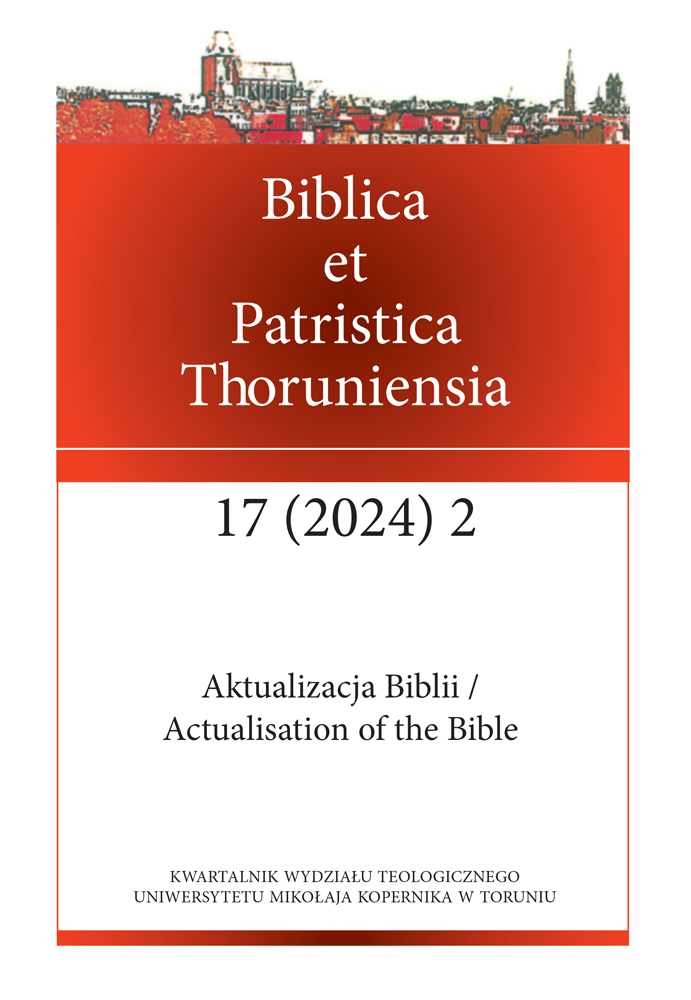¿Qué mujer bajo la ley? Un análisis de las figuras de Sara y Agar según Gálatas 4, 21–31 en la exégesis de Hilario de Poitiers
DOI:
https://doi.org/10.12775/BPTh.2024.008Słowa kluczowe
Hilary z Poitiers, egzegeza, soteriologia, Nowy TestamentAbstrakt
Która kobieta pod Prawem? Analiza postaci Sary i Hagar według Listu do Galatów 4, 21–31 w egzegezie Hilarego z Poitiers
Jedną z niezwykłych cech analizy cyklu Abrahama przez Hilarego z Poitiers w odniesieniu do wiary i wyboru jest jego egzegeza Sary i Hagar. Rzeczywiście, porównanie faktów opisanych w Księdze Rodzaju z ich traktowaniem w korpusie Pawłowym jest paradoksalne: w jaki sposób Sara, która nie była w stanie zaufać aniołowi w Mamre i która manipulowała warunkami obietnicy, angażując swoją niewolnicę Hagar, którą traktowała okrutnie, może stać się postacią Kościoła, podczas gdy Hagar jest kojarzona z poniżającymi cechami niewolnictwa? Niniejszy artykuł przeanalizuje zakres, w jakim Hilary z Poitiers opiera się na Pawłowej alegorii Sary i Hagar w swojej teorii dyspensacyjnej.
Bibliografia
Aróztegui Esnaola, Manuel. 2005. La amistad del Verbo con Abraham según San Ireneo de Lyon. Roma: Editrice Pontificia Università Gregoriana.
Brawley, Robert L. 2014. „Covenant.” En The Oxford encyclopedia of the Bible and ethics, vol. 1, edited by Robert L. Brawley, 122–130. New York: Oxford University Press.
Betz, Hans Dieter. 1979. Galatians: A Commentary on Paul's Letter to the Churches in Galatia. Philadelphia: Fortress Press.
Dabourne, Wendy. 1999. Purpose and Cause in Pauline Exegesis. Romans 1.16–4.25 and the New Approach to the Letters. Cambridge: Cambridge University Press.
Devilliers, Luc. 2005. La saga de Siloé. Jésus et la fête des Tentes (Jean 7, 1–10, 21). Paris: Cerf.
Doignon, Jean. 1953. „Adsumo et adsumptio come expressions du mystère de l’Incarnation chez Hilaire de Poitiers.” Archivum Latinitatis Medii Aevi 23: 123–135.
Doignon, Jean. 1982. „Erat in Iesu Christo homo totus (Hilaire de Poitiers, In Matthaeum 2,5). Pour une saine interpretation de la formule.” Revue d’Etudes Augustiniennes et Patristiques 28: 201–207.
Ferreira, Manuel. 1995. Fe e profecía em santo Hilário de Poitiers. Lisboa: Edições Didaskalia.
Harstine, Stanley. 2002. Moses as a Character in the Fourth Gospel. London: Sheffield Academic Press.
Heinsch, Ryan. 2022. The figure of Hagar in Ancient Judaism and Galatians. Tübingen: Mohr Siebeck.
Ladaria, Luis F. 1989. La cristología de Hilario de Poitiers. Roma: Editrice Pontificia Università Gregoriana, 1989.
Orbe, Antonio. 1987. Introducción a la teología de los siglos II y III. Salamanca: Sígueme.
Pollmann, Karla y Elliott, Marc W. 2014. „Galatians in the Early Church: Five Case Studies.” En Galatians and Christian Theology: Justification, the Gospel, and Ethics in Paul’s Letter, edited by Marc W. Elliott, et al., 41–60. Grand Rapids: Baker Academic.
Riches, John. 2008. Galatians through the Centuries. Oxford–Malden: Blackwell.
Tan, Andrew Kimseng. 2018. The Rhetoric of Abraham’s Faith in Romans 4. Atlanta: Society of Biblical Literature Press.
Wright, N.T., Wall, Robert W. y Sampley, J. Paul. 2002. The New interpreter's Bible. Volume X, The Acts of the Apostles, introduction to epistolary literature, the letter to the Romans, the first letter to the Corinthians. Nashville: Abingdon Press.
Wright, N.T. 2009. Justification: God’s Plan and Pauls’s Vision. InterVarsity Press, Drowner’s Grove.
Wright, N.T. 2013. „Paul and the Patriarch: The Role of Abraham in Romans 4.” Journal for the Study of the New Testament 35 (3): 207–241.
Pobrania
Opublikowane
Jak cytować
Numer
Dział
Licencja
Prawa autorskie (c) 2024 Almudena Alba López

Utwór dostępny jest na licencji Creative Commons Uznanie autorstwa – Bez utworów zależnych 4.0 Międzynarodowe.
CC BY ND 4.0. Posiadaczem prawa autorskiego (Licencjodawcą) jest Autor, który na mocy umowy licencyjnej udziela nieodpłatnie prawa do eksploatacji dzieła na polach wskazanych w umowie.
- Licencjodawca udziela Licencjobiorcy licencji niewyłącznej na korzystanie z Utworu/przedmiotu prawa pokrewnego w następujących polach eksploatacji: a) utrwalanie Utworu/przedmiotu prawa pokrewnego; b) reprodukowanie (zwielokrotnienie) Utworu/przedmiotu prawa pokrewnego drukiem i techniką cyfrową (e-book, audiobook); c) wprowadzania do obrotu egzemplarzy zwielokrotnionego Utworu/przedmiotu prawa pokrewnego; d) wprowadzenie Utworu/przedmiotu prawa pokrewnego do pamięci komputera; e) rozpowszechnianie utworu w wersji elektronicznej w formule open access na licencji Creative Commons (CC BY-ND 3.0) poprzez platformę cyfrową Wydawnictwa Naukowego UMK oraz repozytorium UMK.
- Korzystanie przez Licencjobiorcę z utrwalonego Utworu ww. polach nie jest ograniczone czasowo ilościowo i terytorialnie.
- Licencjodawca udziela Licencjobiorcy licencji do Utworu/przedmiotu prawa pokrewnego nieodpłatnie na czas nieokreślony
PEŁEN TEKST UMOWY LICENCYJNEJ >>
Statystyki
Liczba wyświetleń i pobrań: 218
Liczba cytowań: 0



